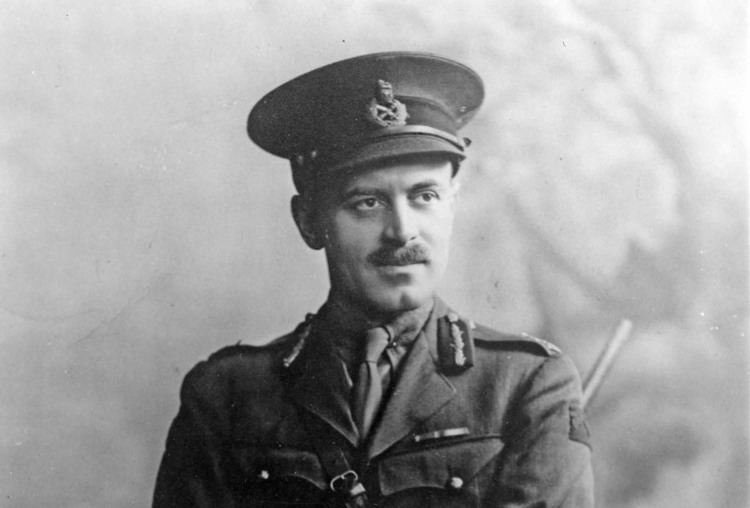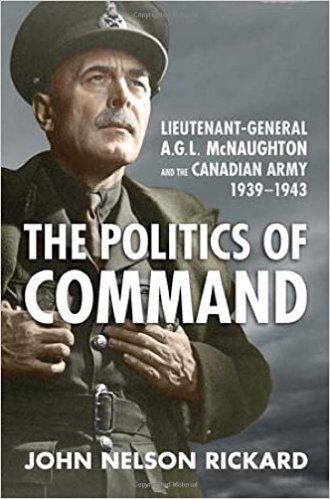Allegiance Canada Service/branch Canadian Army Years of service 1909–1944 | Name Andrew McNaughton | |
 | ||
Full Name Andrew George Latta McNaughton Awards Order of the Companions of Honour (1946)Companion of the Order of the Bath (1935)Companion of the Order of St Michael and St George (1919)Distinguished Service Order (1917)Canadian Forces Decoration (1955)Queen's Privy Council for Canada (1944)Grand Officer of the Order of Leopold (1946) Battles/wars World War IWorld War II Died July 11, 1966, Montebello, Canada Education | ||
Battles and wars World War I, World War II | ||
Delivering high speed two with bim andrew mcnaughton the b1m
General Andrew George Latta McNaughton (25 February 1887 – 11 July 1966) was a Canadian scientist, army officer, cabinet minister, and diplomat.
Contents
- Delivering high speed two with bim andrew mcnaughton the b1m
- Andrew mcnaughton with franz dannerbauer s music liberation unit
- Early life
- First World War
- Chief of the General staff
- Formation of relief camps
- National Research Council of Canada
- Second World War
- After the war
- Promotions
- References

Andrew mcnaughton with franz dannerbauer s music liberation unit
Early life

Born in Moosomin, Saskatchewan (at the time in the Northwest Territories), on 25 February 1887, McNaughton was a student at Bishop's College School in Lennoxville, Quebec. He earned a B.A. from McGill University in Montreal in 1910, where he was a member of The Kappa Alpha Society, and an MSc in 1912.
First World War

McNaughton joined the Canadian militia in 1909. He took the 4th Battery of the Canadian Expeditionary Force overseas with the outbreak of the First World War in 1914 and arrived in France in February 1915.
While there he helped make advances in the science of artillery, and was wounded twice. The need to accurately pinpoint artillery targets, both stationary and moving, led to his invention of a target detection technique using an oscilloscope which was the forerunner of radar. He sold the rights to that invention to the Government of Canada for only $10.
In March 1916 he was promoted to Lieutenant-Colonel and returned to England to take command of the newly arrived 11 (Howitzer) Brigade RCA, taking it to France in July. In early 1917 he was appointed the Counter Battery Staff Officer of the Canadian Corps. On the day before the armistice he was promoted to Brigadier-General and appointed General Officer Commanding Canadian Corps Heavy Artillery.
Chief of the General staff
In 1920 McNaughton joined the regular army and in 1922 was promoted to Deputy Chief of the General Staff and Chief of the General Staff in 1929. During that time he worked at mechanising the army and modernising the militia.
Formation of relief camps
By the summer of 1932, due to the massive unemployment caused by the Great Depression, Canada had become poverty-stricken with much of the populace left destitute. While on a tour of the nation's military establishments General McNaughton was shocked by the spectacle of homeless men living in shacks, begging on the streets of Western cities and swarming aboard freight trains to move on to the next town or city in search of a job. McNaughton recognised that here was a situation where the possibility of revolution didn't seem unreal. In October he presented a proposal eagerly grasped by Prime Minister R. B. Bennett, that had two aims. It would get the men off the streets, out of the cities and out of sight, and, at the same time improve their bodies and provide useful work in a group of camps, run by the military. In the so-called "relief camps" men would be fed, clothed and housed, and would work on projects of national importance—building airfields, highways and other public works. As an "alternative to bloodshed on the streets," this stop-gap solution for unemployment was to establish military-run and -styled relief camps in remote areas throughout the country, where single unemployed men toiled for twenty cents a day.
Unfortunately, what appeared to be a humanitarian effort to aid the unemployed and indigent and prevent the propagation of revolution soon turned into a hotbed of dissent due to the draconian disciplinary measures adopted. Portions of a letter smuggled out read to the House of Commons by J. S. Woodsworth, MP for Winnipeg North Centre described the conditions.
"Picture to yourself a tarpaper shack 79 feet x 24 with no windows, along each side there is a row of double decker bunks, these are spaced off with 8 × 1 board so that there is room for two men in each bunk. The bunks are filled with straw and you crawl into them from the foot end. Along the front of the lower bunk a narrow board is placed upon which the men may sit. The place is very meagerly lighted and ventilation by three skylights.... So narrow is the passageway between the bunks that when the men are sitting on the bench there is scarcely room to pass between them. This shack houses 88 men.... At times the place reeks of the foul smell and at night the air is simply fetid. The floor is dirty and the end of the shack where the men wash ... is caked with black mud. The toilet is thoroughly filthy, unsanitary, and far too small."
The irony was that McNaughton's scheme for staving off revolution had the seeds of revolution inherent in it. Within two years the camps that had been greeted with such applause would be known throughout the country as slave camps. The "volunteer inmates" were not allowed newspapers, magazines or radios. Any man who left a camp, even for a visit to his family, was subsequently refused re-entry and the "dole" was denied to him.
National Research Council of Canada
He returned for a few years to civilian life and from 1935 to 1939 was head of the National Research Council of Canada. National Research Council Building M50 on the Ottawa Campus was named the McNaughton Building, in his honour. IEEE honours McNaughton in the naming of the McNaughton Medal, presented annually for excellence in engineering.
Second World War
McNaughton commanded the 1st Canadian Infantry Division during the early part of the Second World War, and led the division overseas, first to the United Kingdom in December 1939 and later to France in June 1940, only to be withdrawn back to England in the final stages of the Battle of France. He commanded VII Corps from July to December 1940 when it was renamed the Canadian Corps. Then under his leadership the Canadian Army in the United Kingdom, reinforced with the 2nd Canadian Corps, and the Canadian Corps being redesignated as the 1st Canadian Corps, was organised into the Canadian First Army in April 1942. McNaughton's contribution to the development of new techniques was outstanding, especially in the field of detection and weaponry, including the discarding sabot projectile. He was unduly blamed for the disastrous Dieppe Raid in August 1942, which saw the 2nd Canadian Infantry Division sustain heavy casualties, blame better deserved by the British who failed to provide needed, requested, and promised support. General Sir Alan Brooke, the British Chief of the Imperial General Staff (CIGS), his opponent since the First World War, frequently criticised him. Brooke had been the Staff Officer Royal Artillery in the Canadian Corps during the First World War and organised the "creeping barrages" in support of the assaults at the Battle of Vimy Ridge.
A favourite of Winston Churchill, the British Prime Minister; though in October 1943 he came back from a weekend at Chequers looking limp and told Brooke that he had had a ghastly weekend .... kept up all hours of the morning. Brooke had warned him that Churchill might want him to agree to an operation against Norway (which had twice been turned down as impractical). While he had eventually agreed to examine the Trondheim operation, to Brooke's relief he had since sent a telegram to Mackenzie King that he was on no account to agree to the employment of the Canadian forces in any operations in Norway.
He was sent as envoy for a conference with Stalin. McNaughton, then a Major-General, was cover celebrity for Life magazine in December 1939 when Canada had entered the war, but the USA had not. His support for voluntary enlistment rather than conscription led to conflict with James Ralston, the then Minister of National Defence. Due to pressure by critics and weakened by health problems, McNaughton resigned his command in December 1943.
Because of his support for a volunteer army, McNaughton remained friendly with Prime Minister William Lyon Mackenzie King, who wanted to make him the first Canadian-born Governor General of Canada. Instead, McNaughton became Minister of National Defence when Ralston was forced to resign after the Conscription Crisis of 1944, as King did all he could to avoid introducing conscription. McNaughton was soon pressured into calling for conscription despite King's wishes, a popular move for some Canadians but an equally unpopular one for many others. After losing both a February by-election in the Ontario riding Grey North and, a few months later, the riding of Qu'Appelle, Saskatchewan which he contested in the 1945 federal election McNaughton resigned as Defence minister in August 1945. King had made him take blame for conscription, to which both men had been opposed, and now had to replace him as Governor-General designate. King recommended to the Monarch that the British Field Marshal Sir Harold Alexander be appointed Governor-General, setting back the first appointment of a Canadian to that role by seven more years.
The avenue McNaughton was named in Ottawa, Ontario and unveiled and dedicated to General Andrew McNaughton in 1943. The avenue runs from McGillivray street to Main Street.
After the war
After the war McNaughton chaired the United Nations Atomic Energy Commission from 1946 to 1948; served as Canada's Ambassador to the United Nations from 1948 to 1949; and chaired the Canadian Section of the International Joint Commission from 1950 to 1962.
His grandson Lieutenant-General Andrew Leslie was Chief of the Land Staff of the Canadian Forces from 2006 to 2010.
Promotions
His promotions were:
